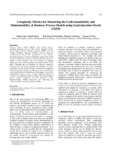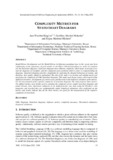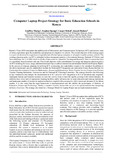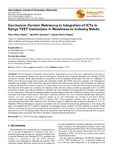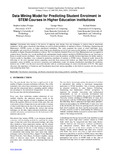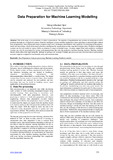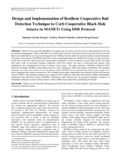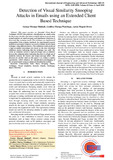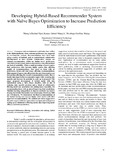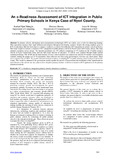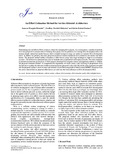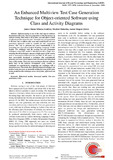Browsing Journal Articles (CI) by Title
Now showing items 23-42 of 123
-
Complexity Metrics for Measuring the Understandability and Maintainability of Business Process Models using Goal-Question-Metric (GQM)
(2008)Business Process Models (BPMs), often created using a modeling language such as UML activity diagrams, EventDriven Process Chains Markup Language (EPML) and Yet Another Workflow Language (YAWL), serve as a base for ... -
Complexity Metrics for Sassy Cascading Style Sheets
(2019-01)Many front-end web developers are nowadays increasingly using sassy cascading stylesheets (SCSS) instead of the regular cascading style sheets (CSS). Despite its increased demand, SCSS has inherent complexity which arises ... -
Complexity Metrics for Statechart Diagrams
(2022-05)Model-Driven Development and the Model-Driven Architecture paradigm have in the recent past been emphasizing on the importance of good models. In the Object-Oriented paradigm one of the key artefacts are the Statechart ... -
Computer Laptop Project Strategy for Basic Education Schools in Kenya
(IJICT Journals, 2017-05)Kenya’s Vision 2030 recognizes the enabling role of Information and Communication Technology (ICT) and anchors some of its key aspirations upon the availability and adoption of computers for schools. The overall objective ... -
COUPLING METRICS FOR ASPECT ORIENTED SOFTWARE
(International Journal of Software Engineering & Applications (IJSEA),, 2025)The Aspect Oriented Software (AOS) paradigm emerged as a response to the limitations of Object-Oriented Programming, specifically its inability to modularize cross-cutting concerns effectively. However, AOS have inherent ... -
Curriculum Content Relevancy in Integration of ICTs in Kenya TVET Institutions in Readiness to Industry Needs
(International Journal of Secondary Education, 2017)The development of curricula content and their implementation is one of the key competences of instructors in the area of educational planning and practical training for Technical and Vocational Education and Training ... -
Data Mining Model for Predicting Student Enrolment in STEM Courses in Higher Education Institutions
(2016-11-11)Educational data mining is the process of applying data mining tools and techniques to analyze data at educational institutions. In this paper, educational data mining was used to predict enrollment of students in Science, ... -
Data Preparation for Machine Learning Modelling
(2022)The world today is on revolution 4.0 which is data-driven. The majority of organizations and systems are using data to solve problems through use of digitized systems. Data lets intelligent systems and their applications ... -
Deep Learning Model for Crop Diseases and Pest Classification
(International Journal of Computer and Information Technology, 2024)The study on deep learning models for crop diseases and pest classification looked at how these models may enhance agricultural practices, specifically for the purpose of more precise pest and crop disease classification. ... -
Design and Implementation of Resilient Cooperative Bait Detection Technique to Curb Cooperative Black Hole Attacks in MANETs Using DSR Protocol
(Scientific & Academic Publishing, 2020-05)Mobile Ad-hoc networks (MANETs) are unique type of wireless networks that are infrastructureless and with no centralised management. Nodes in MANETs act as both routers and hosts. The nodes are free to join and leave the ... -
Detection of Visual Similarity Snooping Attacks in Emails using an Extended Client Based Technique
(2021-04)This paper provides an Extended Client Based Technique (ECBT) that performs classification on emails using the Bayessian classifier that attain in-depth defense by performing textual analysis on email messages and attachment ... -
Developing Hybrid-Based Recommender System with Naïve Bayes Optimization to Increase Prediction Efficiency
(2021-03)Commerce and entertainment world today have shifted to the digital platforms where customer preferences are suggested by recommender systems. Recommendations have been made using a variety of methods such as content-based, ... -
Development of Isolated Numeric Speech Corpus for Swahili Language for Development of Automatic Speech Recognition System
(2013-07)Speech corpus being the basic requirement for the development of Automatic speech recognition (ASR) system, it should be done with much accuracy in order to enhance the performance of the system. This paper describes the ... -
Discriminative spatial-temporal feature learning for modeling network intrusion detection systems
(Journal of Computer Security, 2023-02)Increasing interest and advancement of internet and communication technologies have made network security rise as a vibrant research domain. Network intrusion detection systems (NIDSs) have developed as indispensable defense ... -
An e-Readiness Assessment of ICT Integration in Public Primary Schools in Kenya Case of Nyeri County.
(2017)In primary schools, information and communication technologies (ICT) are widely seen as tools for enhancing learning. This expectation increases their rapid diffusion and adoption throughout developing countries. Despite ... -
An Effort Estimation Method for Service-Oriented Architecture
(2020-10-16)Determining size and effort of SOA systems is critical for managing SOA projects. As a consequence, a number of methods have been proposed to estimate effort of building SOA projects but the problem of estimating SOA ... -
An Empirical Analysis of Encoder Decoder (U Net) Variants for Medical Image Segmentation
(International Journal of Scientific Research in Computer Science and Engineering, 2025)U-Net convolutional neural networks have become a cornerstone in medical image processing, particularly for complex segmentation tasks. However, with the proliferation of various U-Net variants, it is imperative to evaluate ... -
An English-Swahili Email Spam Detection Model for Improved Accuracy Using Convolutional Neural Networks
(Mesopotamian journal of Cybersecurity, 2025)E-mail has become an essential tool for digital communication, facilitating global networking and information exchange. However, spam emails, particularly those in multilingual contexts, pose a significant threat to ... -
An Enhanced Multiview Test Case Generation Technique for Object-oriented Software using Class and Activity Diagrams
(Blue Eyes Intelligence Engineering and Sciences Publication, 2020-11)Software testing is one of the vital steps in software development life cycle. Test case generation is the first process in software testing which takes a lot of time, cost and effort to build an effective product from the ...

